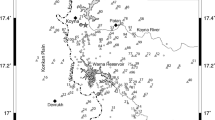Abstract
Delineation of the top sedimentary structure and its Qs vs. Qp relationship using the travel-time difference of direct S and converted Sp phase is key to understanding the seismic hazard of any sedimentary basin area. We constructed filtered displacement waveforms from local ETNA Episensor acceleration recordings as well as local velocity recordings of aftershocks of the 2001 Bhuj earthquake recorded by the Kachchh seismological network of the National Geophysical Research Institute (NGRI), Hyderabad, India during 2001–2004. Stations are within 15–70km of epicenters, and the resulting displacement waveforms are generally simple, displaying prominent P, Sp, and S wave pulses. Particle motion of P and S waves suggest near-vertical raypaths consistent with preliminary depth estimates. The direct S wave on the horizontal component is characterized by lower frequency content than the converted Sp phase on the vertical component. This difference in frequency content between S and Sp phases can be explained in terms of different attenuation effects for P and S waves in the unconsolidated sediments. The Sp phase is generated by S-to-P phase conversion at the base of Mesozoic sediments of the Kachchh basin. Travel-time inversion (VELEST) of 2565 P and 2380 S arrivals from 658 well located aftershocks recorded at 8–14 three-component local seismic stations led to 1 D velocity models indicated very slow sediments in the upper 0–2 km depth range (Vp: 2.92 km/s and Vs: 0.90 km/s) and an increasing trend of velocities with depth at 2–40 km depth. The estimated sediment thicknesses beneath 12 accelerograph and 6 seismograph sites from the estimated velocity model and the travel-time difference between S and converted Sp phases reaches a maximum of (1.534 ± 0.117) km beneath Bandri (near the location of 2001 Bhuj mainshock) and attains a minimum sediment thickness of (0.858 ± 0.104) km beneath Ramvav and Burudia. The spectral ratios between Sp and S from 159 three-component accelerograms have been used to study seismic wave attenuation in the Kachchh rift basin. The estimated Qs vs. Qp relations for 12 accelerograph sites vary from Qs = 0.184 Qp (at Chobari) to Qs = 0.505 Qp (at Dudhai). For stations Chobari, Chopdwa, Jahawarnagar, Vondh and Tapar, the spectral ratio slopes and hence the calculated Qs vs. Qp relations are effectively the same, and the correlation coefficients are quite high (0.91–0.93). Stations Adhoi, Manfara, New Dudhai, Dudhai and Sikara have similar Qs vs. Qp relationships to each other and also have high correlation coefficients (0.78–0.87). The spectral ratios for stations Anjar and Ramvav are small and poorly constrained, resulting in less reliable Qs vs. Qp relations. This could be due to noisy data, fewer available waveforms, or scattering due to velocity heterogeneities and/or interface irregularities.
Similar content being viewed by others
Author information
Authors and Affiliations
Corresponding author
Rights and permissions
About this article
Cite this article
Mandal, P. Sediment Thicknesses and Qs vs. Qp Relations in the Kachchh Rift Basin, Gujarat, India Using Sp Converted Phases. Pure appl. geophys. 164, 135–160 (2007). https://doi.org/10.1007/s00024-006-0158-3
Received:
Accepted:
Issue Date:
DOI: https://doi.org/10.1007/s00024-006-0158-3




